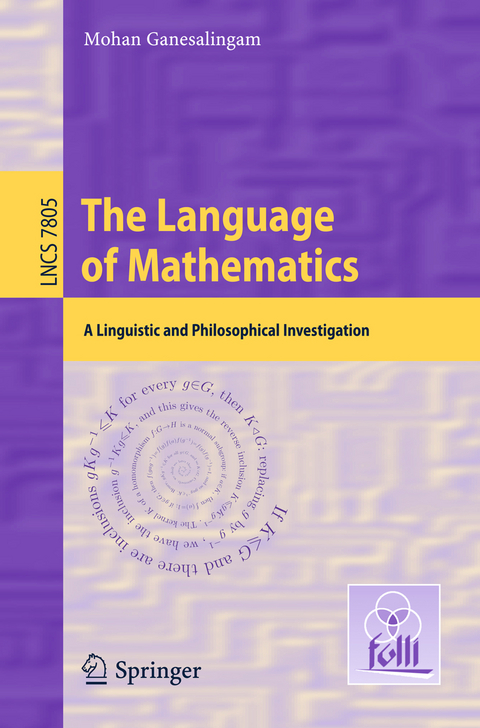The Language of Mathematics
Springer Berlin (Verlag)
978-3-642-37011-3 (ISBN)
The Language of Mathematics was awarded the E.W. Beth Dissertation Prize for outstanding dissertations in the fields of logic, language, and information. It innovatively combines techniques from linguistics, philosophy of mathematics, and computation to give the first wide-ranging analysis of mathematical language. It focuses particularly on a method for determining the complete meaning of mathematical texts and on resolving technical deficiencies in all standard accounts of the foundations of mathematics. "The thesis does far more than is required for a PhD: it is more like a lifetime's work packed into three years, and is a truly exceptional achievement." Timothy Gowers
Introduction.-1.1 Challenges.- 1.2 Concepts.-1.2.1 Linguistics and Mathematic.-1.2.2 Time.- 1.2.3 Full Adaptivity.- .3 Scope.- 1.4 Structure.- 1.5 Previous Analyses.- 1.5.1 Ranta.- 1.5.2 de Bruijn.- 1.5.3 Computer Languages.- 1.5.4 Other Work.- 2 The Language of Mathematics.- 2.1 Text and Symbol.- 2.2 Adaptivity.- 2.3 Textual Mathematics.- 2.4 Symbolic Mathematics. -2.4.1 Ranta's Account and Its Limitations.- 2.4.2 Surface Phenomena.- 2.4.3 Grammatical Status.- 2.4.4 Variables.- 2.4.5 Presuppositions .- 2.4.6 Symbolic Constructions.- 2.5 Rhetorical Structure.- 2.5.1 Blocks.- 2.5.2 Variables and Assumptions.- 2.6 Reanalysis.- 3 Theoretical Framework.- 3.1 Syntax.- 3.2 Types.- 3.3 Semantics.- 3.3.1 The Inadequacy of First-Order Logic.- 3.3.2 Discourse Representation Theory.- 3.3.3 Semantic Functions.- 3.3.4 Representing Variables.- 3.3.5 Localisable Presuppositions.- 3.3.6 Plurals.- 3.3.7 Compositionality.- 3.3.8 Ambiguity and Type.- 3.4 Adaptivity.- 3.4.1 Definitions in Mathematics.- 3.4.2 Real Definitions and Functional Categories.- 3.5 Rhetorical Structure.- 3.5.1 Explanation.- 3.5.2 Blocks.- 3.5.3 Variables and Assumptions.- 3.5.4 Related Work: DRT in NaProChe.- 3.6 Conclusion.- 4 Ambiguity.-4.1 Ambiguity in Symbolic Mathematics.-4.1.1 Ambiguity in Symbolic Material.-4.1.2 Survey: Ambiguity in Formal Languages.-4.1.3 Failure of Standard Mechanisms.- 4.1.4 Discussion.-4.1.5 Disambiguation without Type.- 4.2 Ambiguity in Textual Mathematics.-4.2.1 Survey: Ambiguity in Natural Languages.-4.2.2 Ambiguity in Textual Mathematics.- 4.2.3 Disambiguation without Type.- 4.3 Text and Symbol.- 4.3.1 Dependence of Symbol on Text.- 4.3.2 Dependence of Text on Symbol.- 4.3.3 Text and Symbol: Conclusion.- 4.4 Conclusion.- 5 Type.- 5.1 Distinguishing Notions of Type.- 5.1.1 Types as Formal Tags.- 5.1.2 Types as Properties.- 5.2 Notions of Type in Mathematics.- 5.2.1 Aspect as Formal Tags.- .2.2 Aspect as Properties.- 5.3 Type Distinctions in Mathematics .- 5.3.1 Methodology.- 5.3.2 Examining the Foundations.- 5.3.3 Simple Distinctions.- 5.3.4 Non-extensionality.-5.3.5 Homogeneity and Open Types.- 5.4 Types in Mathematics.- 5.4.1 Presenting Type: Syntax and Semantics.- 5.4.2 Fundamental Type.- 5.4.3 Relational Type.- 5.4.4 Inferential Type.- 5.4.5 Type Inference.- 5.4.6 Type Parametrism.- 5.4.7 Subtyping.- 5.4.8 Type Coercion.- 5.5 Types and Type Theory.- 6 TypedParsing.- 6.1 Type Assignment.- .1.1 Mechanisms.- 6.1.2 Example.- 6.2 Type Requirements.- 6.3 Parsing.- 6.3.1 Type.- 6.3.2 Variables.-6.3.3 Structural Disambiguation.- 6.3.4 Type Cast Minimisation.- 6.3.5 Symmetry Breaking.- 6.4 Example.- 6.5 Further Work.- 7 Foundations.- 7.1 Approach.- 7.2 False Starts.- 7.2.1 All Objects as Sets.- 7.2.2 Hierarchy of Numbers.- 7.2.3 Summary of Standard Picture.- 7.2.4 Invisible Embeddings.- 7.2.5 Introducing Ontogeny.- 7.2.6 Redefinition.- 7.2.7 Manual Replacement.- 7.2.8 Identification and Conservativity.- 7.2.9 Isomorphisms Are Inadequate.- 7.3 Central Problems.- 7.3.1 Ontology and Epistemology.- 7.3.2 Identification.- 7.3.3 Ontogeny.- 7.4 Formalism.- 7.4.1 Abstraction.- 7.4.2 Identification.- 7.5 Application.-7.5.1 Simple Objects.-7.5.2 Natural Numbers.- 7.5.3 Integers.- 7.5.4 Other Numbers.- 7.5.5 Sets and Categories.- 7.5.6 Numbers and Late Identification.- 7.6 Further Work.- 8 Extensions.- 8.1 Textual Extensions.- 8.2 Symbolic Extensions.- 8.3 Covert Arguments.- Conclusion.
Book is based on his dissertation work, which won the Association for Logic, Language, and Information's 2011 Beth prize. ... Ganesalingam's work is thoughtful and thought-provoking. He gives an analysis of mathematical language at a depth not previously attempted, and the results are impressive. Beyond that, in the process he achieves the difficult task of bringing new insight to some very old questions in the philosophy of mathematics. I recommend the book to anyone with an interest in those questions." (Kira Hamman, MAA Reviews, maa.org, May, 2016)
| Erscheint lt. Verlag | 10.2.2013 |
|---|---|
| Reihe/Serie | Lecture Notes in Computer Science | Theoretical Computer Science and General Issues |
| Zusatzinfo | XX, 260 p. 15 illus. |
| Verlagsort | Berlin |
| Sprache | englisch |
| Maße | 155 x 235 mm |
| Gewicht | 415 g |
| Themenwelt | Informatik ► Grafik / Design ► Digitale Bildverarbeitung |
| Informatik ► Theorie / Studium ► Künstliche Intelligenz / Robotik | |
| Schlagworte | Computational Linguistics • Foundations of mathematics • mathematical language • philosophy of mathematics • Semantics |
| ISBN-10 | 3-642-37011-X / 364237011X |
| ISBN-13 | 978-3-642-37011-3 / 9783642370113 |
| Zustand | Neuware |
| Haben Sie eine Frage zum Produkt? |
aus dem Bereich




